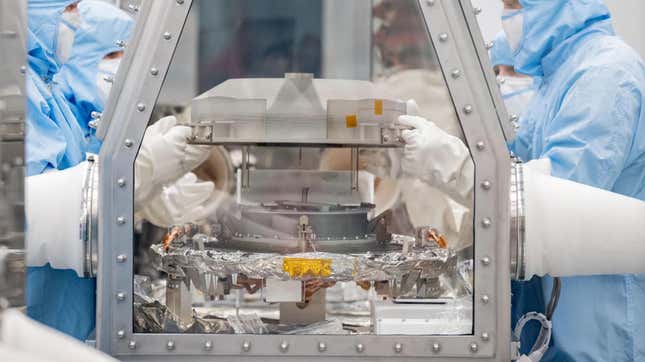
After being dropped off on Earth by the OSIRIS-REx spacecraft, pieces of asteroid Bennu will be revealed to the public for the first time on Wednesday.
NASA will be showing off its first asteroid sample at the Johnson Space Center in Houston on October 11 at 11:00 a.m. ET, and the space agency will be broadcasting the event live so you can get a chance to marvel at the collection of rocks and dust through your screens. The broadcast will be available on NASA TV, the NASA app, and the space agency’s website. Happily, you can also tune in through the feed below.
During the live event, NASA scientists will also discuss initial analysis of the asteroid sample. The team has been hard at work at cracking the sample canister open, carefully disassembling it inside a glovebox to keep out Earthly contaminants. When the aluminum lid to the sample canister was first removed, the mission team found possible extra bits of Bennu on the outside. The bulk of the sample inside is an estimated 8.8 ounces (250 grams) of asteroid rock and dust—roughly enough to fill a can of soup.
Advertisement
NASA’s OSIRIS-REx spacecraft dropped off the asteroid samples in the Utah desert on September 24, from where it was airlifted to a clean room. From there, the clean room team packaged all the parts of the sample capsule for transport by aircraft to the Johnson Space Center the next day. At the space center, NASA designed a new laboratory specifically for the OSIRIS-REx mission.
Advertisement
This is NASA’s first time retrieving a sample straight from an asteroid. The OSIRIS-REx mission launched in September 2016 and reached asteroid Bennu in December 2018. After nearly two years of observations, the spacecraft landed on Bennu and snagged a sample from its surface. On May 10, 2021, OSIRIS-REx began its journey back home to drop off its precious cargo.
Advertisement
The next phase of the mission is now curation and research, distributing samples to scientists around the world for in-depth analysis of the space rock. Some of the sample will also be reserved for future analysis that will take place decades from now, hoping to take advantage of advanced technology in the coming years.
For more spaceflight in your life, follow us on X (formerly Twitter) and bookmark Gizmodo’s dedicated Spaceflight page.
Services Marketplace – Listings, Bookings & Reviews